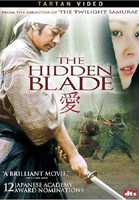
 BUY IT AT AMAZON: CLICK HERE!
BUY IT AT AMAZON: CLICK HERE!
MSRP: $22.95
RATED: R
RUNNING TIME: 132 Minutes
SPECIAL FEATURES:
• Behind-the-scenes w/ director Yoji Yamada
• Berlin Film Festival premiere
• Press Conference w/ Yoji Yamada
• Trailers
The Pitch
"It’s
The
Last Samurai, metaphorically speaking."
The Humans
Masatoshi
Nagase (Suicide Club), Takako Matsu, Yukiyoshi Ozawa.
The Nutshell
At the
time
war,
upheaval. Though the social clashes were not yet at the point of pitched battle
in 1861, the long-standing traditions of the clans and the samurai were under
subtle attack. The ways of the West were beginning to infiltrate the mindsets
of commoners and shogun alike.
The Hidden Blade centers on samurai Munezo
Katagiri (Nagase) during this time, as he becomes aware of the sea change in
his country and his caste, and chooses where he will stand.

The war was awful, son. Got so crowded we had five men to a cannon.
Didn’t have enough jobs for ’em all.
Hell, we had one young punk just to yell curses at the enemy.
The Lowdown
The Hidden Blade is about as elegant as films
come. In its content, it is concerned with the honor of a fading gentry. The
traditions of the samurai, and their gradual dissolution, mirror those of the
American southern gentleman, who were facing their own obsolescence in 1861. Katagiri
carries himself with an honor that is at once admirable and sad, as it
resembles nothing so much as a heavy tool which has become comfortable to hold
only by the growth of calluses. At the same time, the cinematography assembles
a context of static shots with deep focus, like a quiet, transparent eyeball. The
editing lingers on shots of seemingly little consequence, investing the small
moments with import.
All this
elegance is immediately engaging, in part because the story is set in a
provincial farming community. These warriors are samurai in their hearts and to
the people of the village, but to visiting sensei
they are pathetic country bumpkins. It’s hard to resist an affection for these
samurai, who come just this close to deluding themselves. The film spends the
better part of its running time seeking out how it might deepen that audience
affection, including the deployment of a mannered love story almost
Darcy/Elizabeth in its distance and propriety.

-No, your head.
-No, your head.
-Stop copying me!
-Stop copying me!
The
result is a solid core for the conflict that arises for Katagiri. Events conspire
to make him the chosen executioner for a former friend and classmate, Hazama (Ozawa).
Hazama had been sent to
to prison in his clan territories. He escapes from prison, and the Chief
Retainer (a sort of governor) orders Katagiri to hunt him down and kill him in
an honorable duel.
The
conflict isn’t quite what you’d expect. It’s not a case of Katagiri choosing
between his friend and his duty as a samurai; instead, its the much more potent
decision between maintaining the samurai code as his ancestors practiced it or
giving in to the modern alterations in weaponry, tactics, and compromised
honor. Essentially, it’s a duel in Katagiri’s mind between preserving the past
and accepting the future. The most interesting thing about this conflict is
that it remains unresolved when the fight with Hazama concludes. It takes a
glimpse of inhumanity in the Chief Retainer to force Katagiri’s bittersweet
conclusion.
When
undergoing instruction on proper cannon maintenance, one of Katagiri’s fellow
samurai remarks: "Inventing new things and discarding the old; that is the
way of the West." The line functions as a sort of philosophical core to
the film. As Western ideals swell over the centuries-old traditions of the
people of
lead back to whether or not they accept the progression or cling to
familiarity. Katagiri’s choice at the film’s denouement is by no means the
first of such decisions made, but it is the most potent for the way it turns
the consideration just slightly away from the norm and finds a balance between
old and new.

In this picture, there are eighty-three people…
The Hidden Blade is a film that celebrates grace
both in story and in technical achievement. It’s a fine meditation on
flexibility of spirit, as well as being a sweet love story. Don’t come to it
looking for a samurai epic; this is an intimate as they come.
The Package
The disc
has some great technical specs. The anamorphic 1.85:1 transfer is beautiful,
and particularly good for the packed mise-en-scene that director Yoji Yamada
seems to prefer. The soundtrack is included both in Dolby and DTS tracks.
Yamada
puts his stamp on the bonus features in a behind-the-scenes featurette, a press
conference, and a sequence from the Berlin Film Festival. None are particularly
filled with information, but Yamada is a fascinating and eloquent speaker in
the bits of wisdom he imparts. No less than you’d expect, really, which is kind
of heartening.
8.2 out of 10